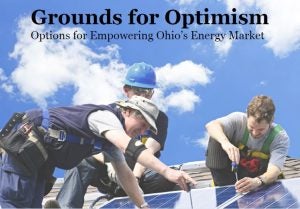 Ohio policymakers are at a crossroads. They can create jobs, grow the economy, cut pollution, and save customers money by rebuilding the state’s renewable and energy efficiency policies, or they can continue to let Ohio fall behind in the clean energy economy.
Ohio policymakers are at a crossroads. They can create jobs, grow the economy, cut pollution, and save customers money by rebuilding the state’s renewable and energy efficiency policies, or they can continue to let Ohio fall behind in the clean energy economy.
A little background: In 2014, the Ohio Legislature placed a two-year freeze on the state’s energy efficiency and renewable energy standards as a result of political pressure from Ohio’s largest power company, FirstEnergy, among others. The standards required electric utilities to generate 12.5 percent of electricity sales from renewable sources, as well as reduce energy consumption 22 percent by 2025 through efficiency programs. Since the freeze, Ohio has lost millions of dollars in energy investment and jobs, and lags behind nearly every other state in percentage of renewable energy generated.
Now that the two years are almost up, it’s time for Ohio to decide how to move forward – if at all – on its clean energy standards. Fortunately, according to a new report from Environmental Defense Fund and The Nature Conservancy, there are at least three achievable routes to reinstate the renewable and efficiency standards – each of which would provide substantial economic and health benefits to the state at a value of $3 to $5 billion by 2030.
[Tweet “Reinvigorating Ohio’s Clean Energy Standards Could Save $5B by 2030. Here’s How.”]
Billions in benefits
To evaluate the most financially beneficial mix of clean energy resources, the report, Grounds for Optimism: Options for Empowering Ohio’s Energy Market, produced three forecasts of the state’s electricity market. The scenarios include an Accelerated Efficiency case, an Intermediate Pathway that provides a balanced mix of renewables and efficiency, and an Expanded Renewables case. These scenarios are compared against a baseline that models an extended freeze of Ohio’s renewable and energy-efficiency standards.
All three scenarios are based on clear trends and achievable targets within the state’s growing clean energy industry. Furthermore, each would enable Ohio to meet the goals of the Clean Power Plan, the nation’s first-ever limit on carbon pollution from power plants.
The forecasts show the renewable energy and energy efficiency industries in Ohio are expected to:
- Create between 82,300 and 136,000 new jobs in Ohio, with the wind industry serving as one of the largest contributors,
- Enhance Ohio’s GDP by $6.7 billion to $10.7 billion by 2030,
- Provide between $28.8 million and $50.9 million in savings for Ohio electricity customers by 2030, and
- Provide between $3 and $5 billion in net benefits by 2030.
In comparison, the baseline – maintaining the freeze – would create zero new jobs, grow the state’s economy by zero dollars, and provide zero savings for Ohioans.
Moreover, how we generate electricity significantly impacts public health. Currently, “Ohio’s coal-heavy generating fleet creates billions in public health costs that are borne by citizens,” according to the report. By increasing renewable energy and efficiency, Ohioans would avoid asthma attacks, heart attacks, pulmonary issues, and other illnesses that would otherwise occur under the baseline. And public health benefits grow over time: The value would exceed $1 billion every year from 2030 onward in all three scenarios.
Governor Kasich seeks standards
Ohio Governor John Kasich recently attended The Texas Tribune festival, where he was asked about his stance on the Buckeye State’s clean energy standards. Although he feels the original policies were overly ambitious, he was very clear on his message to the Ohio legislature, stating, “If you try to kill the standards […], I’ll veto the bill and we’ll go to the higher standards. I’m committed to it.”
In other words, Governor Kasich is determined to see Ohio thaw the freeze and begin to rebuild its clean energy prowess.
If the legislature is wondering how to go about doing so, this new report from The Nature Conservancy and Environmental Defense Fund can serve as a roadmap to getting the Buckeye State back on track. It clearly lays out three paths for creating jobs and growing the state’s economy, while lowering electricity bills and healthcare costs for Ohioans in the long run. The analysis offers flexibility and an array of options, all of which are far superior to letting the freeze stand, or replacing the standards with a toothless goal. The clean energy choices are there – take your pick, Ohio.
Download the full report here and the factsheet here.









